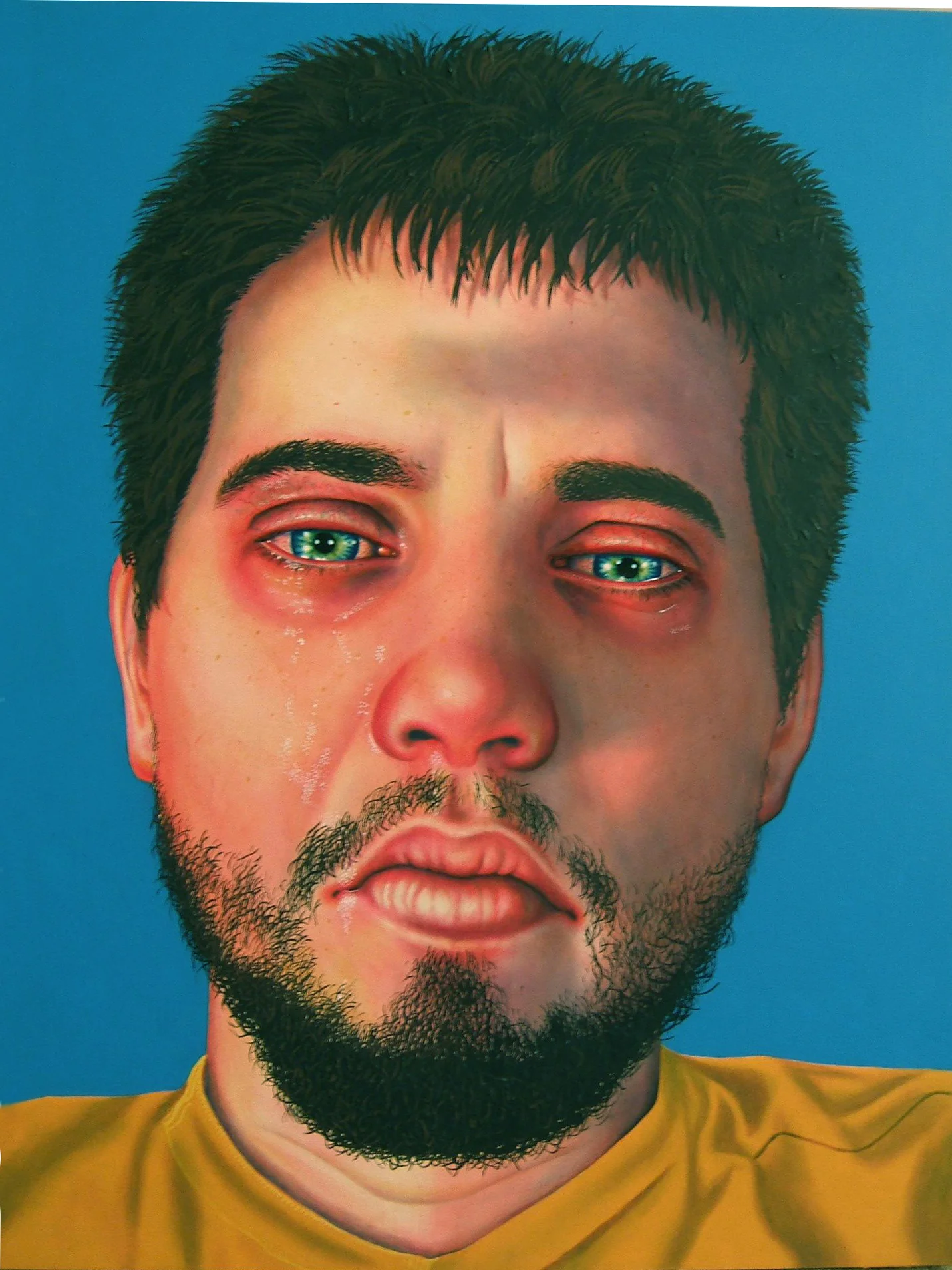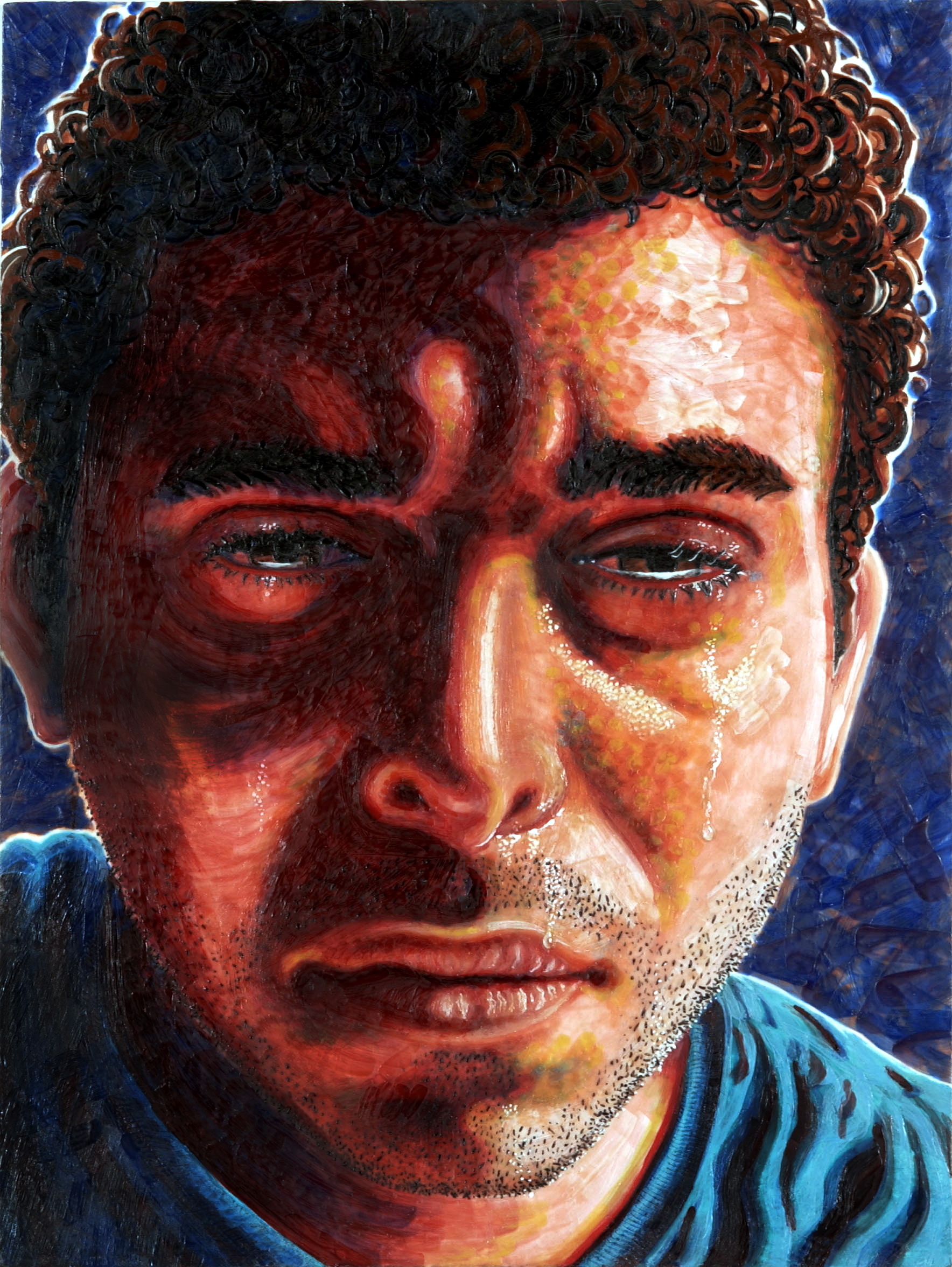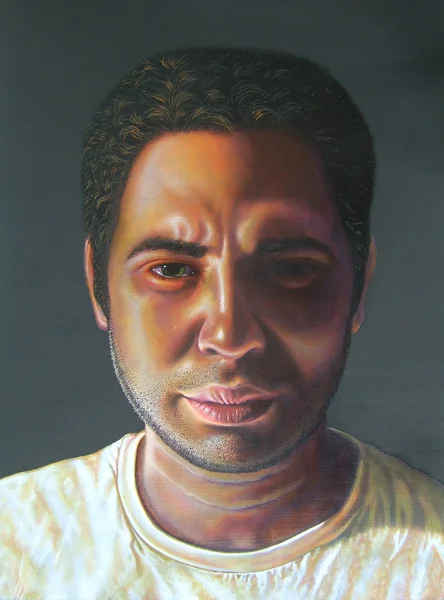






















































































Your Custom Text Here
My oil and acrylic paintings take anywhere from 3-12 months. Architect Ludwig Mies van der Rohe once said "God is in the details." In my work, the details are often painted with a 20/0 brush, and are vital to maximize psychological impact. In addition, I employ a time-consuming Renaissance glazing technique in my work. In this process, thin layers of transparent paint are applied to the surface of a painting. The darkest areas of the painting could have as many as 30 glazes on them. This technique creates the illusion that the lightest areas of the paintings are glowing, or giving off light. This is because light rays go through the transparent layers, hit the white of the gessoed canvas, and bounce back out at the viewer.
The light in the image carries content. Some areas have many layers of dark glazes, and this is a perceptual as well as psychological "pushing back" of the objects and what they represent This process replicates night vision, where the longer you look, the more you see. In this age of ever-shortening attention spans, I like to reward people for standing there and taking the time to really look.
I feel that the dedication and investment of time involved in my work is a defiant act in the age I find myself living in. I have never done assembly line paintings: I don't get an idea, then make 20 variations on it so that I will have a "series". Each painting is a full blown love affair, not an infatuation, and they are hard to give up. People often look at my work when it is half completed, and say "it's done, right?...what else could you do to it?" I don't stop working on a painting until there is nothing that I could possibly do to make it more powerful or more resonant.
My oil and acrylic paintings take anywhere from 3-12 months. Architect Ludwig Mies van der Rohe once said "God is in the details." In my work, the details are often painted with a 20/0 brush, and are vital to maximize psychological impact. In addition, I employ a time-consuming Renaissance glazing technique in my work. In this process, thin layers of transparent paint are applied to the surface of a painting. The darkest areas of the painting could have as many as 30 glazes on them. This technique creates the illusion that the lightest areas of the paintings are glowing, or giving off light. This is because light rays go through the transparent layers, hit the white of the gessoed canvas, and bounce back out at the viewer.
The light in the image carries content. Some areas have many layers of dark glazes, and this is a perceptual as well as psychological "pushing back" of the objects and what they represent This process replicates night vision, where the longer you look, the more you see. In this age of ever-shortening attention spans, I like to reward people for standing there and taking the time to really look.
I feel that the dedication and investment of time involved in my work is a defiant act in the age I find myself living in. I have never done assembly line paintings: I don't get an idea, then make 20 variations on it so that I will have a "series". Each painting is a full blown love affair, not an infatuation, and they are hard to give up. People often look at my work when it is half completed, and say "it's done, right?...what else could you do to it?" I don't stop working on a painting until there is nothing that I could possibly do to make it more powerful or more resonant.
Gunlicker I (detail)
Gunlicker I
"Gunlicker I", 2015, acrylic & oil on gatorboard, 20 x 16" oval
Copy of Gunlicker IV, detail
2016, oil and acrylic on Gatorboard, 20 x 16" (working photo)
Gunlicker III: Militia
(working photo), 2016, oil and acrylic on gatorboard, 17.5 x 18"
Gunlicker II
2015, oil & acrylic on Gatorboard, 20 x 16" (working photo)
Gunlicker II (detail)
Gunlicker II (detail)
(working photo)
"The Appetites of Oligarchs"
2015-2018, oil, acrylic & gold leaf on canvas, 72 x 50.25"
Detail: The Appetites of Oligarchs
Storm
"Storm", acrylic, embroidery on cotton velvet, 72 x 48”, 2015
Storm (embroidery detail)
Insomnia II
2010, latex, watercolor, and gouache on paper, 24 x 14"
Testosterone
2010, gouache on paper, glitter frame, 18 x 22"
Woman With An Urgent Vocation (and A Master's Degree)
2010, gouache on paper, two 11 x 14" pieces
Like Flies
2014, gouache & Prismacolor pencil on paper, 24 x 18"
Like Flies (detail)
Lack of Magic
2010, watercolor and gouache on paper, 24 x 18"
Requiem... For Wassily & The Ineffable
2007, acrylic / oil on canvas, 79 x 116" triangular shaped canvas
Requiem... (bottom detail)
Requiem.... (bottom detail)
Requiem.... (extreme detail)
Requiem... (right detail)
Requiem (left detail)
Requiem.... (center detail)
Blessed Art Thou
2006, 88 x 60", oil & acrylic on linen
Blessed Art Thou (detail)
Blessed Art Thou (detail)
Blessed Art Thou (detail)
Blessed Art Thou (detail)
Blessed Art Thou (detail)
Sentinel, Paralyzed
2008-09, 20 x 16" oval, latex, gouache, embroidery on paper.
Sentinel, Paralyzed (embroidery detail)
Sentinel, Paralyzed (detail)
Astray
2012, embroidery, gouache, and latex on paper, 20 x 16" oval
Astray (detail)
The Initiate
2007, oil, gesso, found carpet, 60 x 24” (destroyed)
The Initiate (detail)
Close.
2000, oil on canvas, assorted sizes, all life-size features
Jesus Nightlight
1997, oil on canvas, 60 x 38”
Fate Of A Technicolor Romantic
2000, acrylic/oil on canvas, 72 x 96”
Fate of A Technicolor Romantic (detail)
Fate Of A Technicolor Romantic (detail)
Fate of A Technicolor Romantic (detail)
Fate Of A Technicolor Romantic (detail)
Fate of A Technicolor Romantic (detail)
Crying Man II
2005, acrylic & oil on panel, 24 x 18"
Crying Man I
2004, encaustic (wax) on masonite, 24 x 18”
Crying Man I (detail)
Crying Man III
2005, embroidery on red velvet, 24 x 18". David Gorman collection, NYC
Crying Man III (detail)
Crying Man IV
2007, oil, black gesso on masonite, 24 x 18”
Crying Man IV (detail)
Sacred Ovaries
2001, acrylic/oil on canvas, 70 x 42”
Sacred Ovaries (detail)
Sanctum series, I - IV
Frost Museum Installation, all encaustic on double layer of wood, 4 x 3"
Sanctum series, V - VIII
Frost Museum Installation, all encaustic on double layer of wood, 4 x 3"
Sanctum I
2004, encaustic (wax) on wood (two layers), 4 x 3”. James Swope & Scott Robertson collection, West Palm Beach
Sanctum IV
2004, encaustic on double layer of wood, 4 x 3". Frost Museum Collection.
How To Act, Not React, When He Makes You Crazy, p. 52
1997, oil/canvas, 36 x 62”
How To Act (detail)
Cleave.
2001, acrylic/oil on canvas, 62 x 72”
Cleave. (detail)
Cleave. (detail)
Extinguish.
1997, oil on canvas, 30 x 20"
Extinguish (detail)
Ten Ways To Win Him Without Losing Yourself, p. 93
1996, acrylic/oil on masonite, 16 x 20”. Jeff Speck collection
Ten Ways.... (detail)
How To Tell If He Is Lying To You, p. 47
1996, acrylic/oil/masonite, 24 x 18”. Sarah Petruziello collection
Taking Me Away From All of This....
1994, acrylic/oil on canvas, 64 x 60”
How to Not Be A Victim of Your Own Expectations, p. 63
1996, oil on canvas, 73 x 56”. Private collection, France
I Let Him, But I Didn't Really Like It
1994, acrylic / oil / linen, 72 x 72”
I Let Him... (detail)
I Let Him... (detail)
Kim Hiding
1994, acrylic/oil on linen, 38 x 54". Carol Stavropoulos collection
Kim Hiding (detail)
3:15
1994, acrylic / oil / linen, 41 x 65”
Miami Landscape II
2006, oil on canvas, 36 x 48"
Miami Landscape II (detail)
Miami Landscape
1998, acrylic/oil on canvas, 52 x 40”. Jeff Speck collection, Washington, DC
Miami Landscape (detail)
Nocturnal Theater II
1992, acrylic/oil on canvas, 51 x 62”. Morris Corporation Public Art Fund collection
Nocturnal Theater II (detail)
Nocturnal Theater I
oil on canvas, 30 x 20", Sam Furiness collection.
Nocturnal Landscape III
1994, acrylic/oil on canvas, Carol Stavrapoulos collection
Close.
2000, oil on canvas, assorted sizes, all life size features